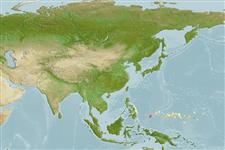>
Ovalentaria/misc (Various families in series Ovalentaria) >
Pomacentridae (Damselfishes) > Pomacentrinae
Etymology: Pomacentrus: Greek, poma, -atos = cover, operculum + Greek, kentron = sting (Ref. 45335); albiaxillaris: Named for its diagnostic white color of the pectoral-fin axil; compound adjective..
Environment: milieu / climate zone / depth range / distribution range
Ecologie
marien rifbewoner; diepte 4 - 15 m (Ref. 114927), usually 4 - 15 m (Ref. 114927). Tropical
Verspreiding
Landen | FAO regio's | Ecosystemen | Voorkomen | Point map | Introducties | Faunafri
Western Pacific: apparently restricted to Palau.
Grootte / Gewicht / Leeftijd
Maturity: Lm ? range ? - ? cm
Max length : 7.0 cm SL mannelijk / geslacht onbekend; (Ref. 114927)
Korte beschrijving
Determinatiesleutels | Morfologie | Morfometrie
Dorsale stekels (totaal) : 13; Dorsale zachte stralen (totaal) : 12 - 15; Anale stekels: 2; Anale zachte stralen: 13 - 15; Wervels: 26. This species is distinguished by the following characters: D XIII,12-15 (usually 14); A II,13-15 (usually 14); pectoral-fin rays 16-18 (usually 18); tubed lateral-line scales 15-18 (rarely 15-16); total gill rakers on first arch 22-25 (usually 23-24); body depth 2.0-2.2 in SL; no scales on preorbital, a single row of scales on suborbital, often restricted to posterior part, continuing around posterior margin of eye; colour in life generally gray to bluish gray with thick black or dark-brown scale margins creating a network pattern; a small black spot restricted to the uppermost portion of pectoral-fin base; both sides of pectoral-fin axil white; dorsal and anal fins are dark gray or blackish with translucent portion posteriorly; caudal fin whitish; dorsal scleral surface of eye is bright blue. This species differs from from other members of the philippinus complex by having a small black spot restricted to the uppermost part of the pectoral-fin base vs. a large black spot that completely covers the base, and by having a white pectoral-fin axil vs. other colors or not especially colored (Ref. 114927).
Levenscyclus en paargedrag
Maturities | Voortplanting | Spawnings | Egg(s) | Fecundities | Larven
Allen, G.R., M.V. Erdmann and P.D. Pertiwi, 2017. Descriptions of four new species of damselfishes (Pomacentridae) in the Pomacentrus philippinus complex from the tropical western Pacific Ocean. J. Ocean Sci. Found. 25:47-76. (Ref. 114927)
Status op de Rode Lijst van het IUCN (Ref. 130435)
Gevaar voor de mens
Harmless
Gebruik door de mens
Tools
Speciale rapporten
Download XML
Internetbronnen
Estimates based on models
Fylogenetische diversiteitsindex (Ref.
82804): PD
50 = 0.5000 [Uniqueness, from 0.5 = low to 2.0 = high].
Bayesian length-weight: a=0.02399 (0.01139 - 0.05051), b=2.98 (2.81 - 3.15), in cm total length, based on LWR estimates for this Genus-body shape (Ref.
93245).
Trofisch niveau (Ref.
69278): 2.7 ±0.3 se; based on size and trophs of closest relatives
Weerstandsvermogen (Ref.
120179): Hoog, minimale populatieverdubbelingstijd minder dan 15 maanden (Preliminary K or Fecundity.).
Fishing Vulnerability (Ref.
59153): Low vulnerability (10 of 100).
